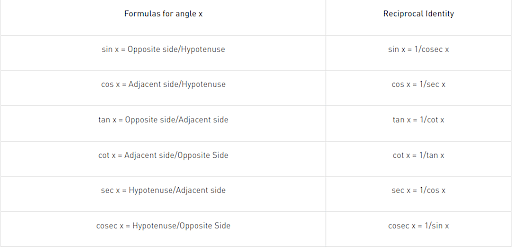In \(Δ\)PQR, right angled at Q, PR + QR = 25 cm and PQ = 5 cm. Determine the values of sin P, cos P and tan P.
Solution and Explanation
Given that,
PR + QR = 25
PQ = 5 Let PR be x.
Therefore, QR = 25 - x

Applying Pythagoras theorem in \(Δ\)PQR, we obtain
\(\text{PR}^ 2 = \text{PQ}^ 2 + \text{QR}^ 2 \)
\(x^2= (5)^ 2 + (25 - x)^ 2 \)
\(x^2= 25 + 625 + x^ 2 - 50x \)
\(50x=650\)
\(x=13\)
Therefore, PR = 13 cm
QR = (25 - 13) cm = 12 cm
\(\text{sin p} =\frac{\text{ Opposite Side}}{\text{Hypotenuse }}= \frac{QR}{PR} = \frac{12}{13}\)
\(\text{sin p} = \frac{\text{Opposite Side}}{\text{Hypotenuse }}= \frac{QR}{PR} =\frac{ 12}{13}\)
\(\text{tan p} =\frac{\text{Opposite Side}}{\text{Adjacent side }}= \frac{QR}{PQ} = \frac{12}{5}\)
Top Questions on Trigonometric Ratios
If $\tan \theta = \tfrac{3}{4}$, then the value of $\cos \theta$ will be:
- UP Board X - 2025
- Mathematics
- Trigonometric Ratios
- Evaluate \( \dfrac{2 \tan 30^\circ}{1 + \tan^2 30^\circ} \)
- AP POLYCET - 2025
- Mathematics
- Trigonometric Ratios
- If \( 15 \cot A = 8 \), then \( \sin A = \, ? \)
- AP POLYCET - 2025
- Mathematics
- Trigonometric Ratios
- Evaluate \( (\sec A + \tan A)(1 - \sin A) = \ ? \)
- AP POLYCET - 2025
- Mathematics
- Trigonometric Ratios
- Which of the following is true?
- AP POLYCET - 2025
- Mathematics
- Trigonometric Ratios
Questions Asked in CBSE X exam
- In our houses we receive A.C. electric power of 220 V. In electric iron or electric heater cables having three wires with insulation of three different colours – red, black and green are used to draw current from the mains. What are these three different wires called? Name them colourwise. What is the potential difference between the red wire and the black wire? What is the role of the wire with green insulation in case of accidental leakage of electric current to the metallic body of an electrical appliance?
- CBSE Class X - 2025
- Electricity
"तुम सुनकर सुख पाओगे, देखोगे – यह गागर रीती ।" कहकर कवि ने अपने जीवन के किस पहलू पर प्रकाश डाला है ?
- CBSE Class X - 2025
- प्रश्न उत्तर
- Matilda’s character embodies the journey of change or progression throughout the story, encapsulating the transformations she endured as a consequence of her experiences, trials, and engagements with other characters.
In the light of the above information, trace the transformation seen in Matilda’s character in the story.
(The Necklace) - Read the given details of a computer.
electronic device that can store and process information makes life easy and simple physical description — monitor, keyboard, CPU and mouse computer technology used in all fields — education, medicine, commerce, entertainment Analyze the details and write an analytical paragraph in about 120 words about the description and role of computers in today’s world.- CBSE Class X - 2025
- Writing Skills
- Explain with examples the significance of the Non-Cooperation Movement in the Indian national movement.
- CBSE Class X - 2025
- Nationalism in India
Concepts Used:
Trigonometric Functions
The relationship between the sides and angles of a right-angle triangle is described by trigonometry functions, sometimes known as circular functions. These trigonometric functions derive the relationship between the angles and sides of a triangle. In trigonometry, there are three primary functions of sine (sin), cosine (cos), tangent (tan). The other three main functions can be derived from the primary functions as cotangent (cot), secant (sec), and cosecant (cosec).
Six Basic Trigonometric Functions:
- Sine Function: The ratio between the length of the opposite side of the triangle to the length of the hypotenuse of the triangle.
sin x = a/h
- Cosine Function: The ratio between the length of the adjacent side of the triangle to the length of the hypotenuse of the triangle.
cos x = b/h
- Tangent Function: The ratio between the length of the opposite side of the triangle to the adjacent side length.
tan x = a/b
Tan x can also be represented as sin x/cos x
- Secant Function: The reciprocal of the cosine function.
sec x = 1/cosx = h/b
- Cosecant Function: The reciprocal of the sine function.
cosec x = 1/sinx = h/a
- Cotangent Function: The reciprocal of the tangent function.
cot x = 1/tan x = b/a
Formulas of Trigonometric Functions:
